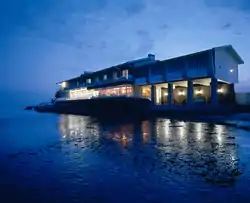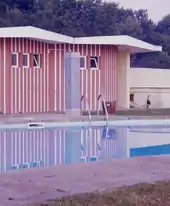| Hostel of Ria | |
|---|---|
Pousada da Ria | |
 A view of the Pousada da Ria after sunset, along the waters of the Ria estuary | |
| General information | |
| Type | Hostel |
| Architectural style | Modern |
| Location | Torreira |
| Town or city | Murtosa |
| Country | |
| Coordinates | 40°43′8.46″N 8°41′54.88″W / 40.7190167°N 8.6985778°W |
| Opened | 20th century |
| Technical details | |
| Material | Granite |
| Website | |
| www.pousadas.pt | |
The Pousada da Ria (Portuguese: Pousada da Ria/Pousada of Murtosa) is situated in the civil parish of Torreira in the municipality of Murtosa, district of Aveiro. It is part of the Pousadas de Portugal network of hostels, classified under the "Pousada of Nature" designation.
History
The hostel was constructed in 1959 by the Serviços de Construção e Conservação (Construction and Conservation Services), and inaugurated in 1960.[1] The hostel was integrated into the network of Pousadas de Portugal, under the a group of Pousadas Natureza (nature hostels).[1] It was included as part of the first phase in the construction new hostels; it was the second constructed in the Beira-Mar series.[1] This includes several projects, among them Nazaré (Ruy Jervis d'Athouguia) and Portinho da Arrábida (a project adapted by Leonardo Castro Freire), but, the project was never brought to term, except Aveiro and the Pousada do Infante (in Sagres).[1]
On 24 August 2006, the building was in process of classification (per Decree-Law 173/2006, Diário da República, Série 1, 16), which revoked the special protection zone created on 18 November 1932 (Decree 21/875), that regulated buildings of architectural importance.[1] On 23 March 2009, the DRCCentro proposed the closing of the brief to classify the building, which was supported, on the 30 March 2009, by a similar closing by the director of IGESPAR.[1]
Architecture

The Pousada is located along the southern arm of the isthmus between the municipality of Murtosa and Aveiro, between the beaches of São Jacinto (along the coast) and the protected natural reserve of the Ria estuary.[1][2] It is a zone of transitional watercourses, between the interior waterways and the Atlantic coast.[1] It is situated in the civil parish of Torreira known for its local architecture that includes the Chapel of São Paio and the parochial church.[3]
The hostel conforms to a "L"-shape plan, of articulated spaces and covered in tile.[1] This includes a principal 2-storey body that runs parallel to the river, with various varandas and terraces over the water.[1] Along the same orientation is a body that is one-storey, but withdrawn, that corresponds to the laundry and ancillary annexes.[1] At the intersection, is a narrow, two-storey body with the ground floor occupied by support services and the second-floor by guest rooms.[1] The Pousada includes 20 rooms (including two suites) with views of the Ria de Aveiro, where it is common to observe the traditional work of the Moliceiros (the fishermen that guide the traditional Aveiro boats) and the fishing along the Ria.[1] The characteristics of the Ria also allow it to be a prime spot for boat trips and water sports.[1]
This pousada has no real historical significance; in fact, it is more along the lines of a two-storey inn and very hotel-like.[4]
See also
References
Notes
- 1 2 3 4 5 6 7 8 9 10 11 12 13 14 Bandeira, Filomena; Basto, Sónia (2011), SIPA (ed.), Pousada da Ria/Pousada de São Jacinto (IPA.00017340/PT020112040005) (in Portuguese), Lisbon, Portugal: SIPA – Sistema de Informação para o Património Arquitectónico, retrieved 2 October 2016
- ↑ The Nature Reserve of São Jacinto (Portuguese: Reserva Natural de São Jacinto Reserve), with an area of1,645 acres (7 km2), was created by Decree in 1979, with the aim of preserving the sand dunes and the areas flora and fauna.
- ↑ The Chapel of São Paio, dates from 1878, but was remodelled and renovated three times, since the two previous incarnations collapsed due to unstable terrain. The current building was remodelled in 1995, and includes a well-preserved 18th century altarpiece and sculptures from the 16th and 18th centuries.
- ↑ Roberts, Bruce (2008). "Sunrise at Monsaraz: Portugal Dreamin'". Renfrew (Ontario), Canada: General Store Publishing House. pp. 68. ISBN 978-1-897508-03-9.
Sources
- Vaz da Silva, Helena (2006), Pousadas de Portugal: Moradas de Sonho, Edições Inapa, ISBN 972-797-130-X
- Lobo, Susana (2007), Pousadas de Portugal: Reflexos da Arquitectura Portuguesa do Século XX, Coimbra, Portugal: Universidade de Coimbra, ISBN 978-972-8704-92-6
- Alonso, Pilar (2002), Visita Pousadas de Portugal, Everest Editora, ISBN 972-750-732-8
- ENATUR, ed. (2000), Pousadas de Portugal, Edições Asa, ISBN 972-41-1694-8
- Ministério das Obras Públicas, ed. (1960), Relatório da Actividade do Ministério nos Anos de 1959 (in Portuguese), vol. 1, Lisbon, Portugal
{{citation}}: CS1 maint: location missing publisher (link) - DGEMN, ed. (1962), Pousada da Ria (in Portuguese), Lisbon, Portugal
{{citation}}: CS1 maint: location missing publisher (link) - Fernandes, José Manuel (1999), Pousadas de Portugal: obras de raiz e em monumentos, Caminhos do Património (in Portuguese), Lisbon, Portugal
{{citation}}: CS1 maint: location missing publisher (link) - Lobo, Susana (2006), Pousadas de Portugal. Reflexos da Arquitectura Portuguesa no Século XX (in Portuguese), Coimbra, Portugal: Imprensa Universitária de Coimbra